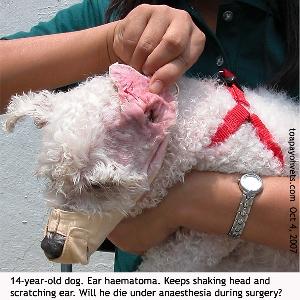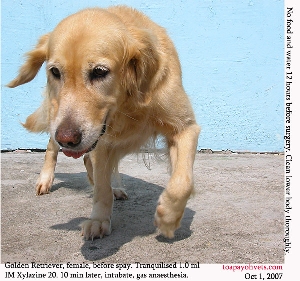 managed to
pry him away from the attention to his
girlfriend to have dinner with
her. She said to the boy who
wanted to stay trim and slim and
was careful of his intake of
calories, "A bone is just a bone.
Eat the last pork rib."
managed to
pry him away from the attention to his
girlfriend to have dinner with
her. She said to the boy who
wanted to stay trim and slim and
was careful of his intake of
calories, "A bone is just a bone.
Eat the last pork rib."Veterinary Anatomy studies can be a very boring subject to the first-year veterinary undergraduate. But it is a matter of life, death and sound reputation to a practising veterinarian.
Last week, I was vaccinating puppies at a pet shop. For want of some common topics to converse with her, I asked her whether she would refer her clients' dogs to me if they want to spay. The recent law that Singapore owners caught with unlicensed dogs would be fined $5,000 had led to an increase in spay operations for vets. A sterilised dog's annual licence fee is $14.00 compared to $70.00.
Do I sound a bit desperate by soliciting from the pet shop? Or is it good business practice? Some of the younger
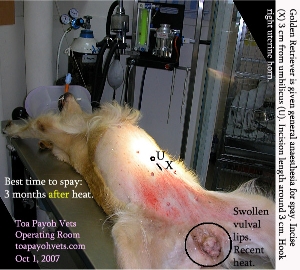 veterinarians
have no qualms soliciting for
business from breeders and solicitation is part of a sound
business strategy.
veterinarians
have no qualms soliciting for
business from breeders and solicitation is part of a sound
business strategy. The pet shop girl arched her eyebrows and frowned, "I never recommend any of my customers to a vet for spay. One of my customers was so angry recently. She kept complaining to me that the veterinarian had cut a very long wound on her female dog. She said that it was an MRT (subway) line! So, I don't refer any customers to any vet."
At least I know her position and policy. I must work harder to build my practice on my own merits.
"Sometimes, a very long incision into the skin may be necessary. There may be bleeding or some complications of surgery and a long skin incision is needed to locate the bleeder. If not, the dog bleeds to death after the spay." I replied. Every vet would encounter this situation at least once in his career.
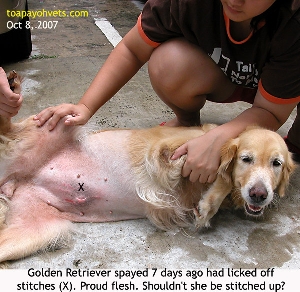 The
pet shop owner had her reputation
to protect, "This customer was
still angry yesterday, at the
extremely long incision on her
poor dog---an MRT line. Kept
moaning about it. "By the way, how
long an incision you cut during
spay?" she asked me.
The
pet shop owner had her reputation
to protect, "This customer was
still angry yesterday, at the
extremely long incision on her
poor dog---an MRT line. Kept
moaning about it. "By the way, how
long an incision you cut during
spay?" she asked me. I replied, "Usually 1.5 to 2 cm long if there are no complications like bleeding. I usually advise 3 months after the end of heat so that the blood vessels of the ovaries and womb are not fragile and bleed easily. It is much safer."
The pet shop girl was not convinced about my experiences or lack of. I could not convince her.
"Is there a portfolio of spay done?" Vets usually do provide portfolios of work done unlike models, photographers or plastic surgeons. I said, "Maybe you can see some pictures at my website." She was surprised I had one.
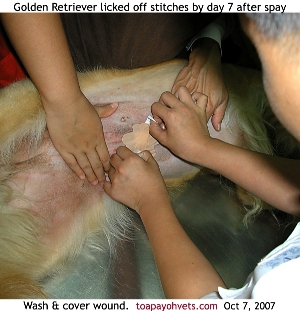 I was there for the vaccination
and microchipping of puppies and
some free consultations.
Nowadays,
In 2009, I seldom provide such services as
they are time-consuming and
private pet owners don't have the
opportunity to consult me when I
am outside doing such work.
I was there for the vaccination
and microchipping of puppies and
some free consultations.
Nowadays,
In 2009, I seldom provide such services as
they are time-consuming and
private pet owners don't have the
opportunity to consult me when I
am outside doing such work. It is good to get out of the office to feel the 'pulse' of the pet market place and do some market research. Owners don't complain directly to the veterinarian when they are not happy with a long incision after spay. Communications, care and compassion are 3 guidelines for a doctor. Maybe in this "MRT spay" dog, the veterinarian had not communicated to the owner the bleeding problems during spay resulting in a long scar.
Veterinary anatomy is a very boring and difficult subject for the first-year undergraduate veterinary student with no farming or animal background because they don't see the relevance. A sound knowledge of veterinary anatomy is essential as the veterinarian is also a surgeon.
It is not possible to have a short spay wound when there are bleeding complications. Nowadays I recommend spaying a dog 3 months after the heat period and unlike 20 years ago, dog owners are much better educated and do accept my advices.
A long incision is necessary to see the bleeding vessel and to ligate it. In this way, the dog does not die from haemorrhage after the spay. In the pictures shown, the incision is the usual 2-cm length much appreciated by the Singapore female dog owners when they send in the dog for spay. A sound knowledge of the location of the ovaries will be useful in achieving such a short incision.
In conclusion, a sound knowledge of veterinary anatomy is especially important when there are bleeding complications during the spay as the veterinarian needs to locate the bleeding vessel inside the abdomen or to perform veterinary surgery.
 TOA
PAYOH VETS
TOA
PAYOH VETS